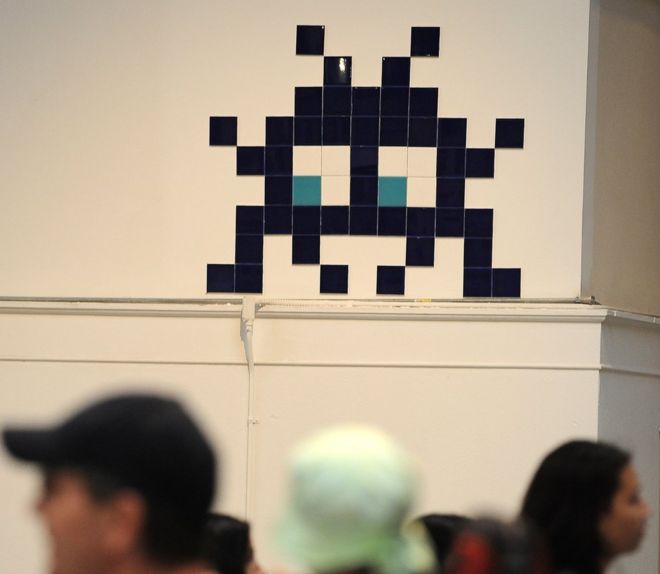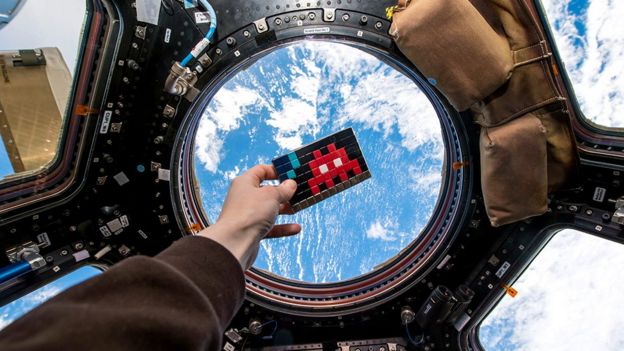How I threw away a work of modern art
 Image copyrightGETTY IMAGES
Image copyrightGETTY IMAGESTo me, it looked like a child’s crude attempt at a mosaic. About a dozen small square tiles of different colours. Glued to the wall in a geometric design vaguely resembling a face with two square eyes.
It stood out in the otherwise empty and dingy Paris flat. Once my home, I was moving back in, after nearly 20 years away. My tenants, three young single men, were showing me round before they left.
“What’s that?” I asked, pointing at the cluster of tiles.
“That’s by Invader,” my tenant replied. “He’s a street artist. He’s like a French Banksy.”
I quite liked Banksy, but the young man must have seen that I didn’t appear overly impressed by his French counterpart.
“You must leave this,” he said earnestly. “One day it will be worth a lot of money.”
 Image copyrightALAMY
Image copyrightALAMYBeing British, I nodded politely – but inwardly I chortled at the notion that a few tiles stuck on a bedroom wall could ever be considered a work of art.
Trying to prove I wasn’t too old to get it, I said: “It reminds me of something.” After struggling for a few seconds to recall exactly what, I exclaimed triumphantly: “Tetris!”
Now it was his turn to look dubious, so I explained: “You know, the video game from the 80s.” “Not Tetris,” he said, mock-patiently. “Space Invaders. The mother of modern video games.”
He added: “The artist came to one of our parties and ended up staying a few months. It was his way of saying thank you. Now we’re leaving it for you.”
Read more about Invader
My neighbours had complained over the years – with varying degrees of indignation and perhaps envy – that the three young men had thrown raucous parties nearly every weekend. The flat was such a wreck that my tenant admitted that, when he was working during the week as an up-and-coming executive, he stayed at his girlfriend’s.
Now he was getting married, while I was about to transform the bachelor party pad back into a respectable bourgeois home.
The wall was stripped, replastered and painted a tasteful shade of blanc cassé
I duly promised the young men that I would look after the artwork and thanked them for leaving it. But then the builders came to replaster and repaint the room.
“I might leave that,” I told them.
They looked at me sceptically. “Why do you want to keep it? It will look strange,” the painter said.
I hesitated, but only for a moment. The wall was stripped, replastered and painted a tasteful shade of blanc cassé – off-white, far more aesthetically pleasing than a bunch of multicoloured tiles.
That was nine years ago, when I was moving back to France.
Find out more
- From Our Own Correspondent has insight and analysis from BBC journalists, correspondents and writers from around the world
- Listen on iPlayer, get the podcast or listen on the BBC World Service, or on Radio 4 on Thursdays at 11:00 and Saturdays at 11:30 BST
As the years passed, I noticed more of the Space Invaders mosaics on buildings around Paris. Never did I feel a twinge of regret for destroying the one in my flat.
Then, two years ago, it began to dawn on me what I’d done.
I reported on how one of the distinctive mosaics of the French street artist known as Invader was about to be displayed – on board the International Space Station. The European Space Agency said it would – in their words – highlight the bridges between art and space.
It was bigger, but otherwise similar to the one I’d unceremoniously stripped out of my flat.
 Image copyrightESA/NASA
Image copyrightESA/NASAInvader was a global phenomenon, famous in New York, Hong Kong, London, and of course Paris.
Then came the real blow. To my horror, I learned that one of his works had sold for more than €200,000 (£178,000; $233,000).
The mosaics I’d once scoffed at are now so sought-after that thieves posing as municipal workers in high-visibility vests went around Paris this summer carefully removing them.
Theft and vandalism have always been problems for Invader, a graduate of the Paris School of Fine Arts who was born in 1969, the year man landed on the Moon.
But there’s a fightback: fans known as “reactivators” photograph his works and reconstruct those that get damaged or disappear.
Had I taken a picture of the one in my flat, I could have called in the reactivators.
Now, I’ll just have to live with the fact that I tossed out a valuable work of art because I preferred a smooth, blank, white wall.
Perhaps I could try to market a piece of that as a work of art. But hold on a minute – hasn’t someone already come up with that concept?